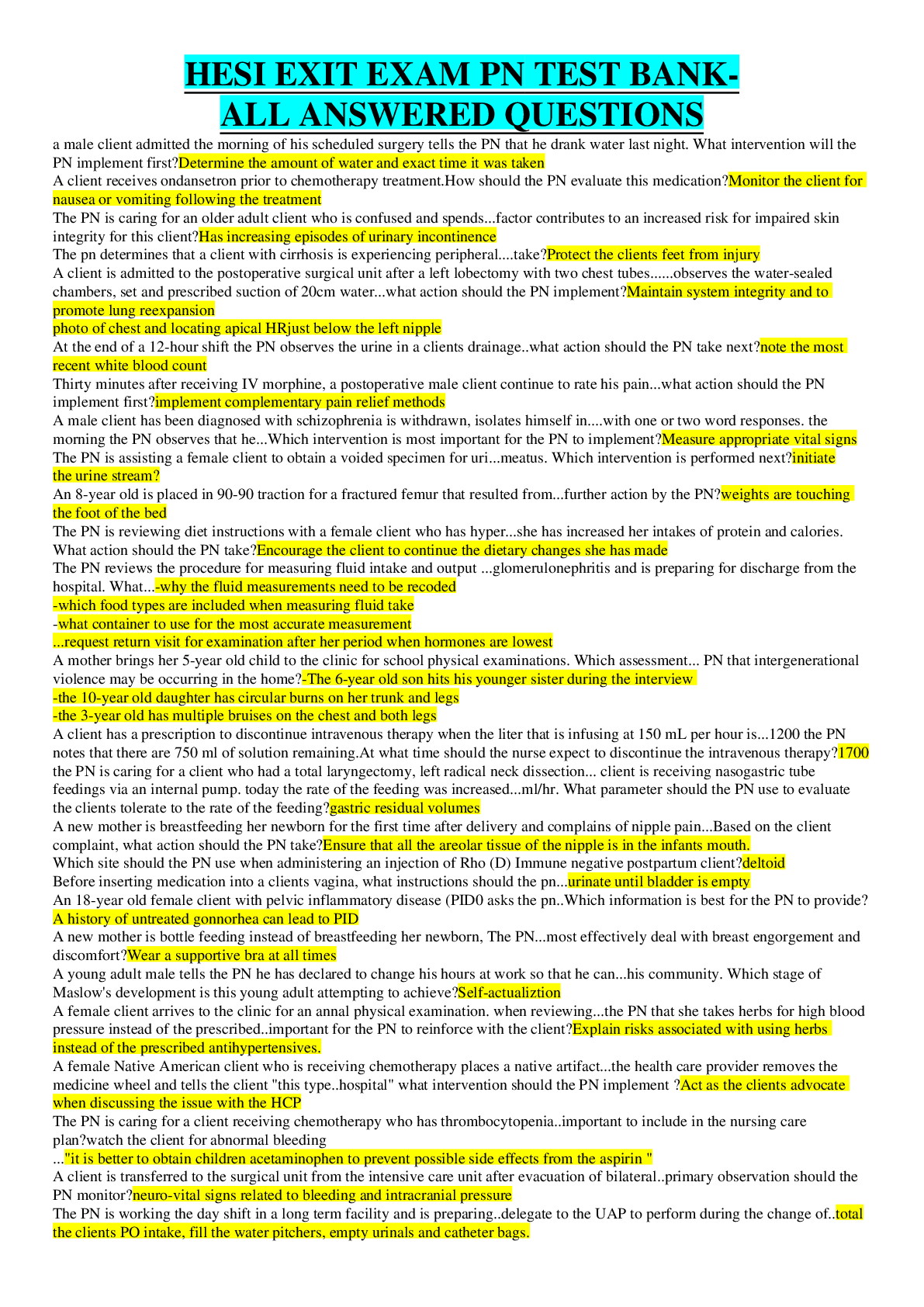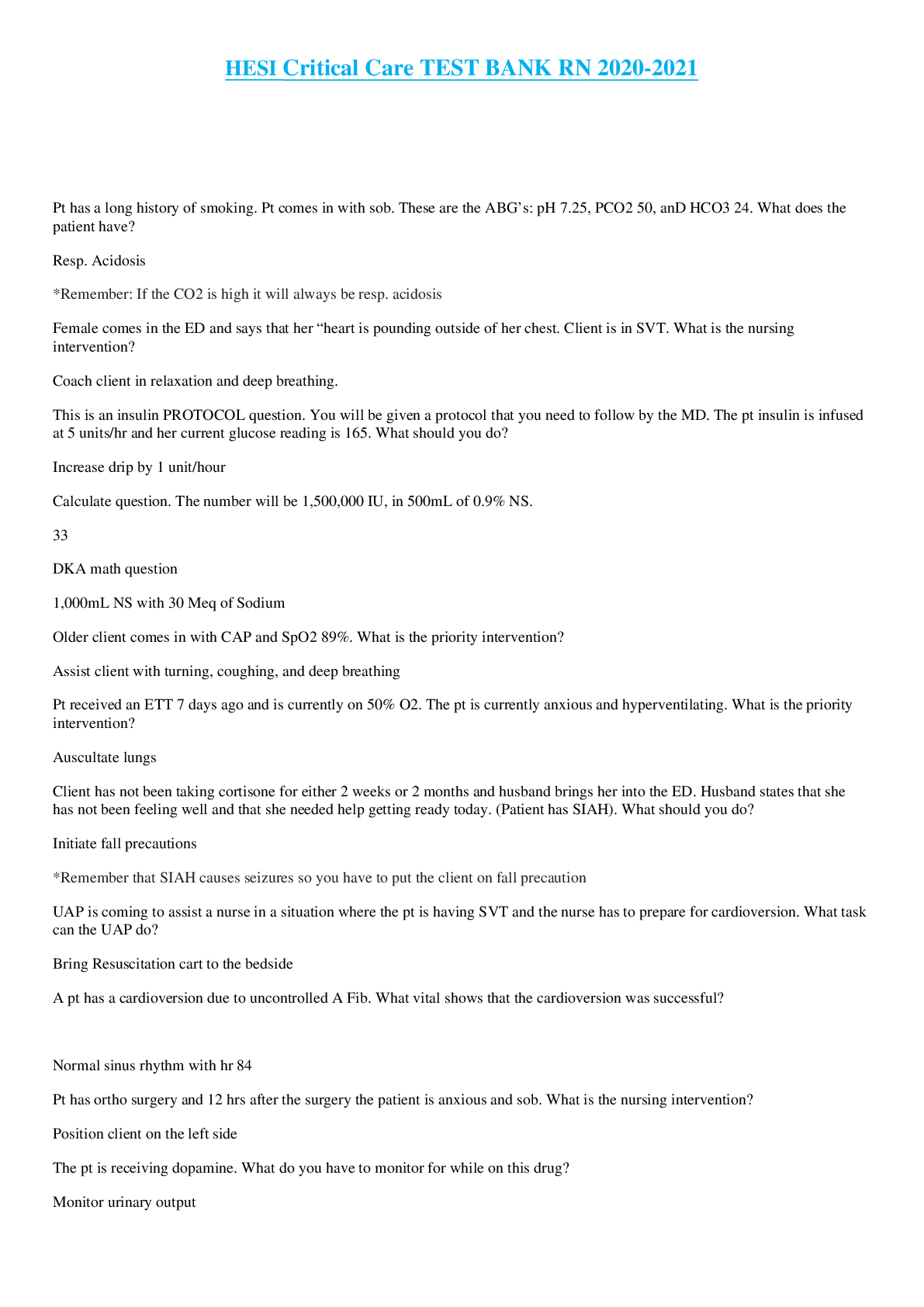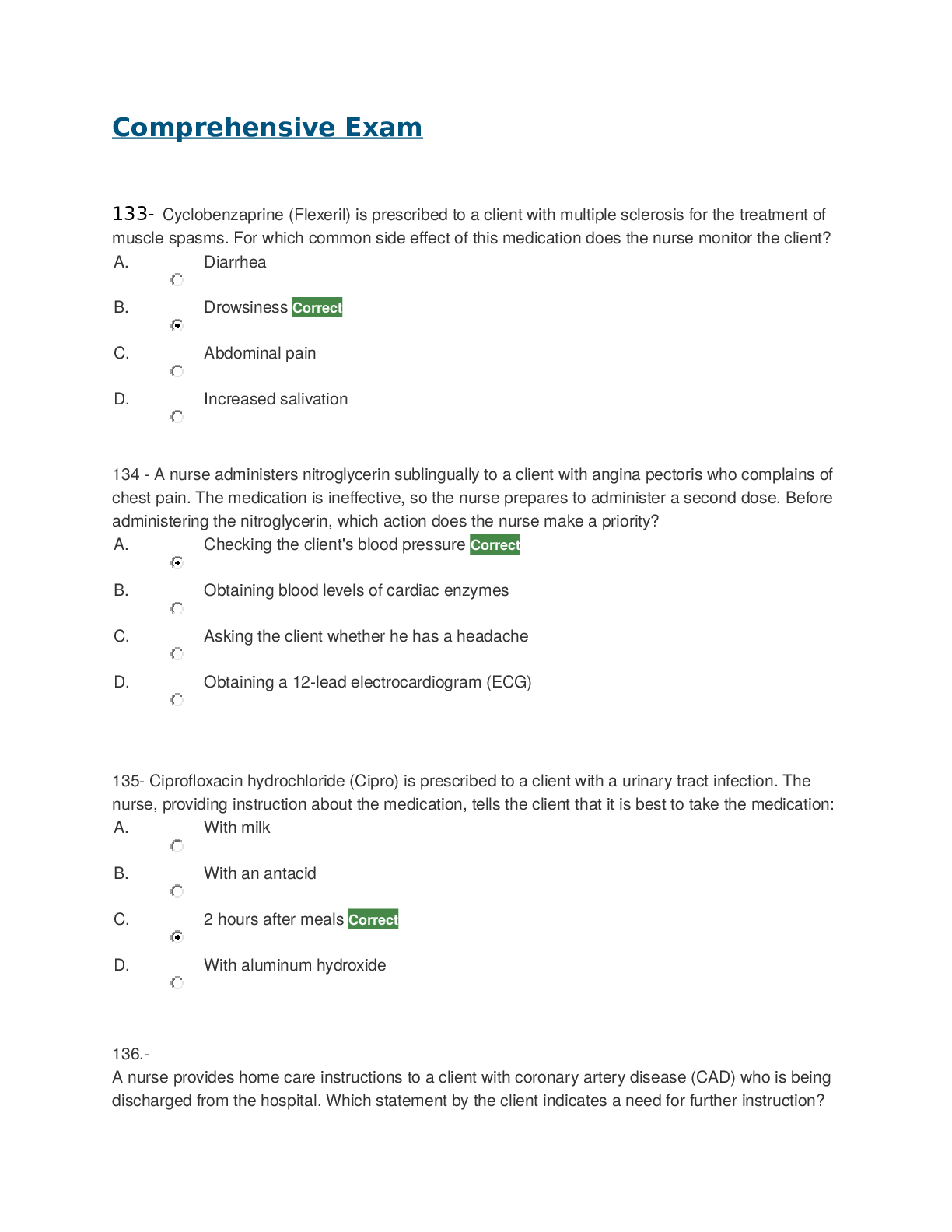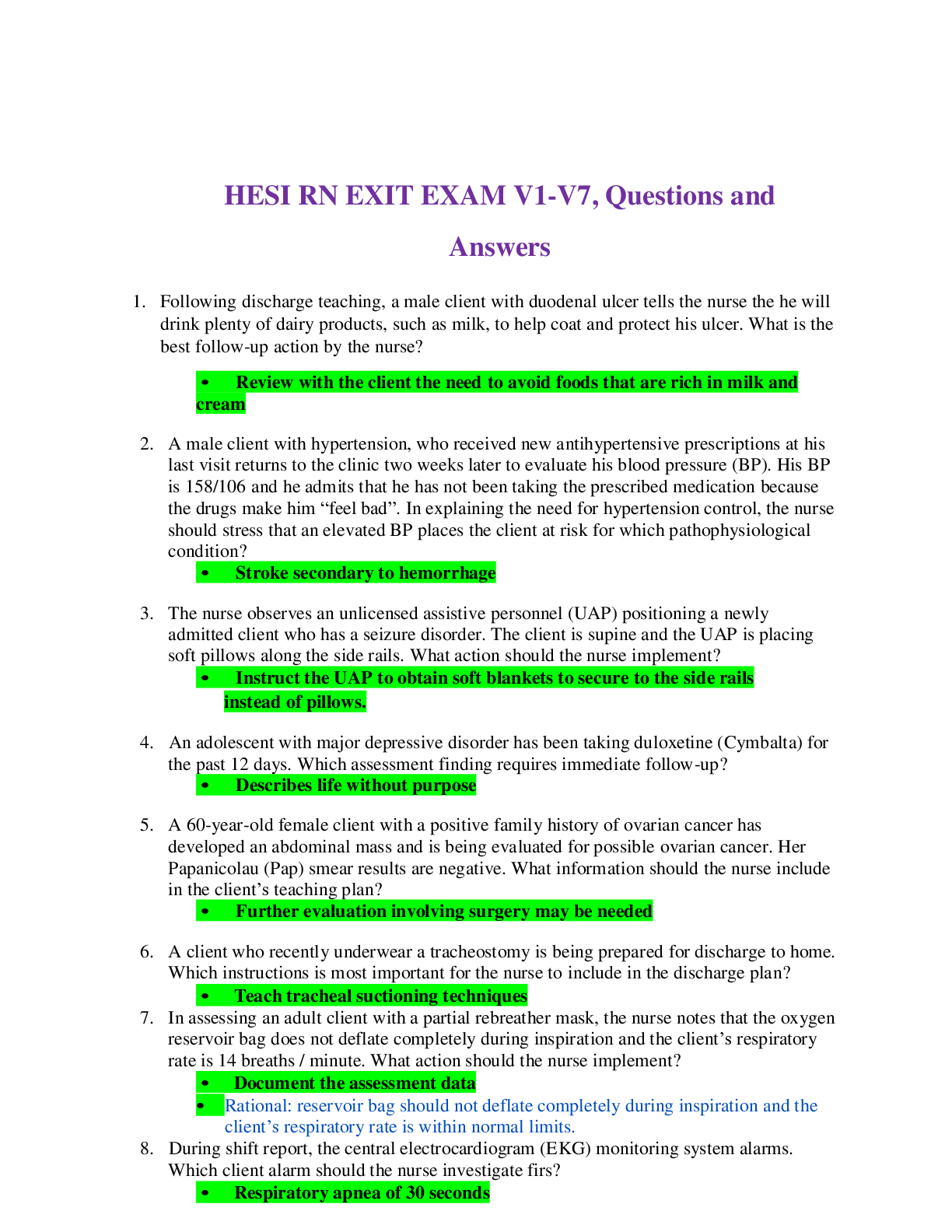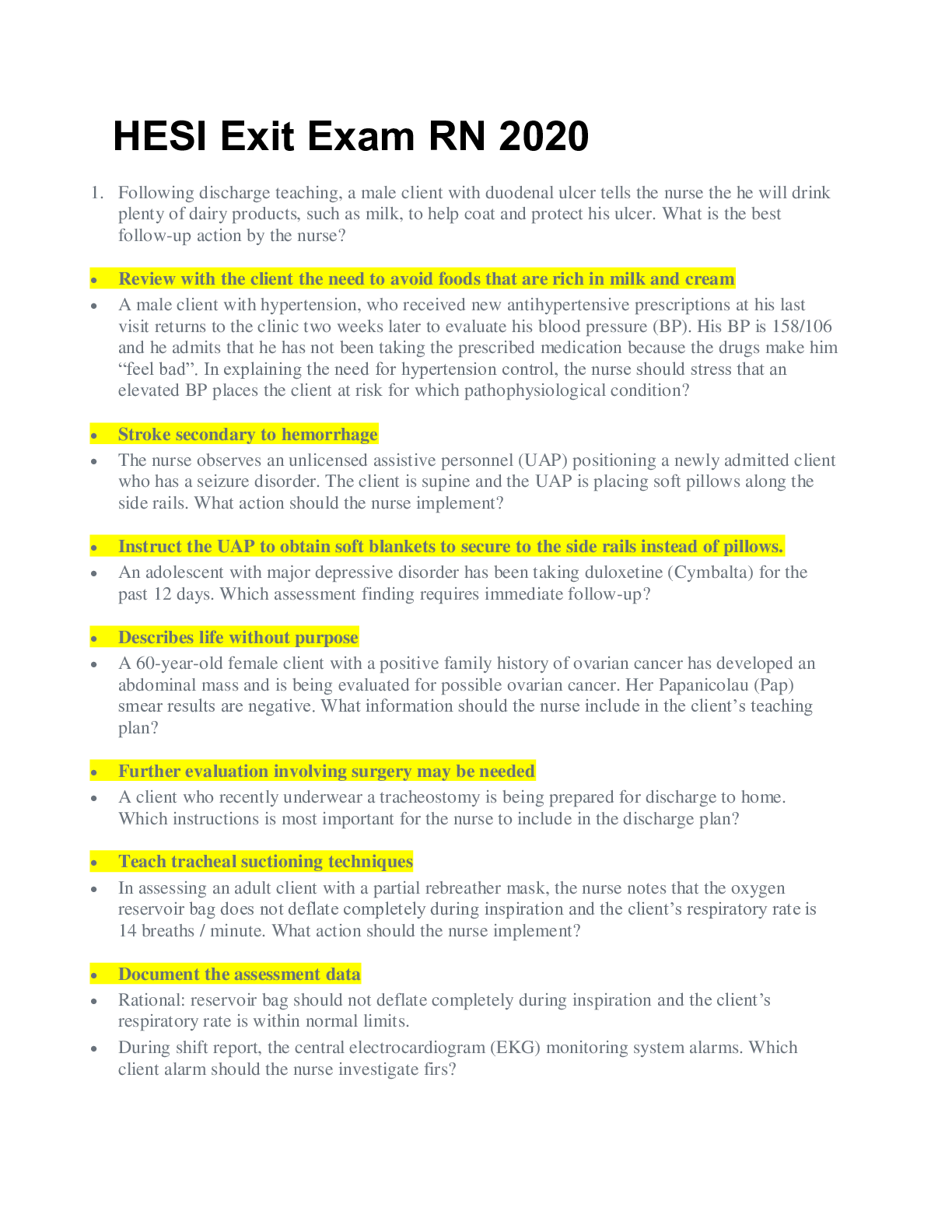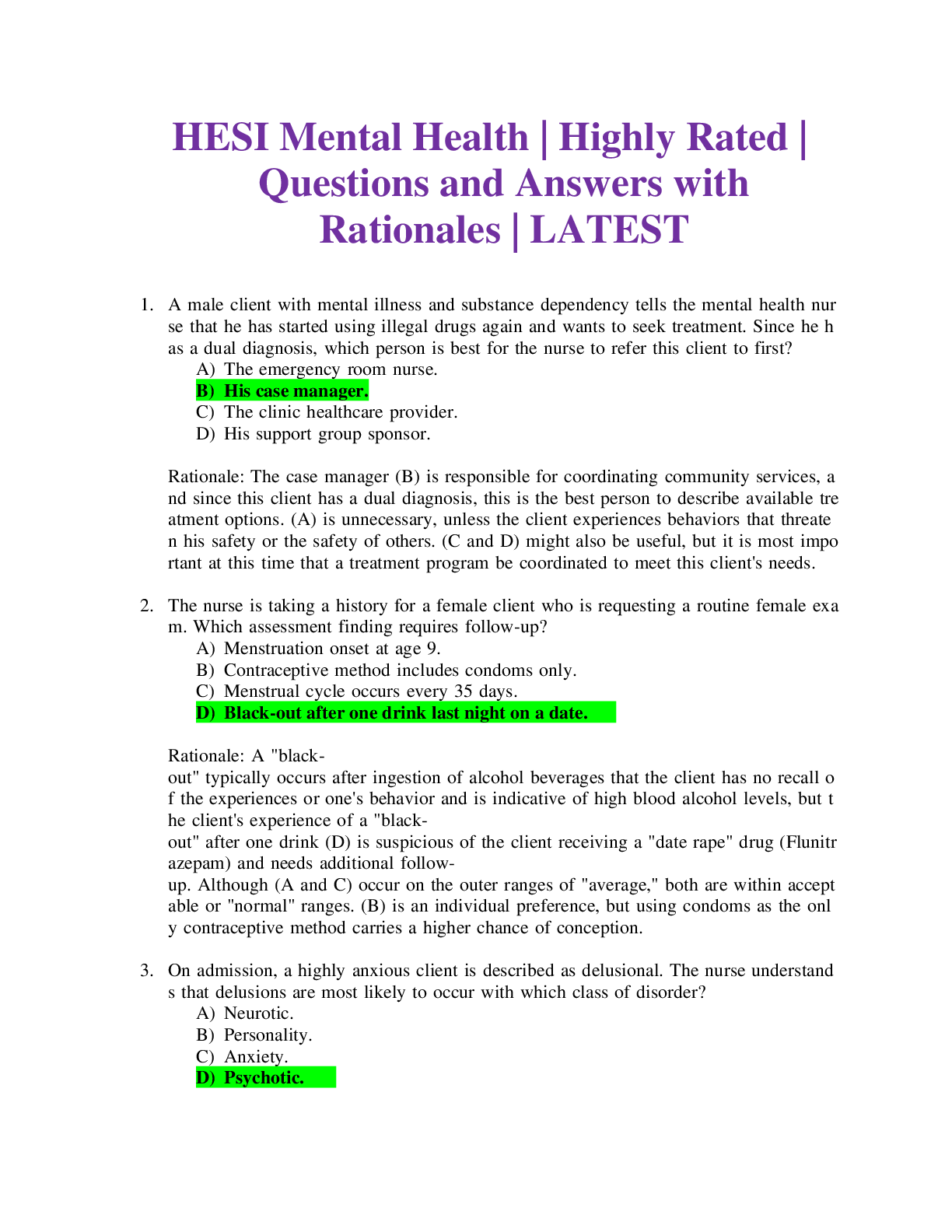HESI Practice Maternity V1 Exam Graded A+
Document Content and Description Below
1. A client has obtained Plan B (levonorgestrel 0.75 mg, 2 tablets) as emergency contraception. After unprotected intercourse, the client calls the clinic to ask questions about taking the contracep... tives. The nurse realizes the client needs further explanation when she makes which of the following responses? 1. "I can wait 3 to 4 days after intercourse to start taking these to prevent pregnancy." 2. "My boyfriend can buy Plan B from the pharmacy if he is over 18 years old." 3. "The birth control works by preventing ovulation or fertilization of the egg." 4. "I may feel nauseated and have breast tenderness or a headache after using the contraceptive." - ANSWER 1. Plan B is a series of contraceptive pills similar in composition to birth control pills that have been used for the past 30 years. Plan B is the brand name for levonorgestrel 0.75 mg. Pills are most effective if taken immediately after unprotected intercourse and then again 12 hours later. Males can purchase this contraceptive as long as they are over 18 years of age. Common side effects include nausea, breast tenderness, vertigo, and stomach pain. CN: Physiological adaptation; CL: Evaluate 2. An antenatal G 2, T 1, P 0, Ab 0, L 1 client is discussing her postpartum plans for birth control with her health care provider. In analyzing the available choices, which of the following factors has the greatest impact on her birth control options? 1. Satisfaction with prior methods. 2. Preference of sexual partner. 3. Breast- or bottle-feeding plan. 4. Desire for another child in 2 years. - ANSWER 3. Birth control plans are influenced primarily by whether the mother is breast- or bottle-feeding her infant. The maternal milk supply must be well established prior to the initiation of most hormonal birth control methods. Low-dose oral contraceptives would be the exception. Use of estrogen-/progesterone-based pills and progesterone-only pills are commonly initiated from 4 to 6 weeks postpartum because the milk supply is well established by this time. Prior experiences with birth control methods have an impact on the method chosen as do the preferences of the client's partner; however, they are not the most influential factors. Desire to have another child in two years would make some methods, such as an IUD, less attractive but would still be secondary to the choice to breast-feed. CN: Pharmacological and parenteral therapies; CL: Analyze 3. After the nurse instructs a 20-year-old nulligravid client on how to perform a breast self-examination, which of the following client statements indicates that the teaching has been successful? 1. "I should perform breast self-examination on the day my menstrual flow begins." 2. "It's important that I perform breast self-examination on the same day each month." 3. "If I notice that one of my breasts is much smaller than the other, I shouldn't worry." 4. "If there is discharge from my nipples, I should call my health care provider." - ANSWER 4. The nurse determines that the client has understood the instructions when the client says that she will notify her primary health care provider if she notices discharge or bleeding because this may be symptomatic of underlying disease. Ideally, breast selfexamination should be performed about 1 week after the onset of menses because hormonal influences on breast tissue are at a low ebb at this time. The client should perform breast self-examination on the same day each month only if she has stopped menstruating (as with menopause). The client's breasts should mirror each other. If one breast is significantly larger than the other, or if there is "pitting" of breast tissue, a tumor may be present. CN: Reduction of risk potential; CL: Evaluate 4. Which of the following would be important to include in the teaching plan for the client who wants more information on ovulation and fertility management? 1. The ovum survives for 96 hours after ovulation, making conception possible during this time. 2. The basal body temperature falls at least 0.2°F (0.17°C) after ovulation has occurred. 3. Ovulation usually occurs on day 14, plus or minus 2 days, before the onset of the next menstrual cycle. 4. Most women can tell they have ovulated because of severe pain and thick, scant cervical mucus. - ANSWER 3. For a client with a typical menstrual cycle of 28 days, ovulation usually occurs on day 14, plus or minus 2 days, before the onset of the next menstrual cycle. Stated another way, the menstrual period begins about 2 weeks after ovulation has occurred. Ovulation does not usually occur during the menses component of the cycle when the uterine lining is being shed. In most women, the ovum survives for about 12 to 24 hours after ovulation, during which time conception is possible. The basal body temperature rises 0.5°F to 1.0°F (0.28°C to 0.56°C) when ovulation occurs. Although some women experience some pelvic discomfort during ovulation (mittelschmerz), severe or unusual pain is rare. After ovulation, the cervical mucus is thin and copious. CN: Health promotion and maintenance; CL: Create 5. Which of the following instructions about activities during menstruation would the nurse include when counseling an adolescent who has just begun to menstruate? 1. Take a mild analgesic if needed for menstrual pain. 2. Avoid cold foods if menstrual pain persists. 3. Stop exercise while menstruating. 4. Avoid sexual intercourse while menstruating. - ANSWER 1. The nurse should instruct the client to take a mild analgesic, such as ibuprofen, if menstrual pain or "cramps" are present. The client should also eat foods rich in iron and should continue moderate exercise during menstruation, which increases abdominal tone. Avoiding cold foods will not decrease dysmenorrhea. Sexual intercourse is not prohibited during menstruation, but the male partner should wear a condom to prevent exposure to blood. CN: Health promotion and maintenance; CL: Apply 6. After conducting a class for female adolescents about human reproduction, which of the following statements indicates that the school nurse's teaching has been effective? 1. "Under ideal conditions, sperm can reach the ovum in 15 to 30 minutes, resulting in pregnancy." 2. "I won't become pregnant if I abstain from intercourse during the last 14 days of my menstrual cycle." 3. "Sperms from a healthy male usually remain viable in the female reproductive tract for 96 hours." 4. "After an ovum is fertilized by a sperm, the ovum then contains 21 pairs of chromosomes." - ANSWER 1. Under ideal conditions, sperm can reach the ovum in 15 to 30 minutes. This is an important point to make with adolescents who may be sexually active. Many people believe that the time interval is much longer and that they can wait until after intercourse to take steps to prevent conception. Without protection, pregnancy and sexually transmitted diseases can occur. When using the abstinence or calendar method, the couple should abstain from intercourse on the days of the menstrual cycle when the woman is most likely to conceive. Using a 28-day cycle as an example, a couple should abstain from coitus 3 to 4 days before ovulation (days 10 through 14) and 3 to 4 days after ovulation (days 15 through 18). Sperm from a healthy male can remain viable for 24 to 72 hours in the female reproductive tract. If the female client ovulates after coitus, there is a possibility that fertilization can occur. Before fertilization, the ovum and sperm each contain 23 chromosomes. After fertilization, the conceptus contains 46 chromosomes unless there is a chromosomal abnormality. CN: Health promotion and maintenance; CL: Evaluate 7. A 20-year-old nulligravid client expresses a desire to learn more about the symptothermal method of family planning. Which of the following would the nurse include in the teaching plan? 1. This method has a 50% failure rate during the first year of use. 2. Couples must abstain from coitus for 5 days after the menses. 3. Cervical mucus is carefully monitored for changes. 4. The male partner uses condoms for significant effectiveness. - ANSWER 3. The symptothermal method is a natural method of fertility management that depends on knowing when ovulation has occurred. Because regular menstrual cycles can vary by 1 to 2 days in either direction, the symptothermal method requires daily basal body temperature assessments plus close monitoring of cervical mucus changes. The method relies on abstinence during the period of ovulation, which occurs approximately 14 days before the beginning of the next cycle. Abstinence from coitus for 5 days after menses is unnecessary because it is unlikely that ovulation will occur during this time period (days 1 through 10). Typically, the failure rate for this method is between 10% and 20%. Although a condom may increase the effectiveness of this method, most clients who choose natural methods are not interested in chemical or barrier types of family planning. 8. Before advising a 24-year-old client desiring oral contraceptives for family planning, the nurse would assess the client for signs and symptoms of which of the following? 1. Anemia. 2. Hypertension. 3. Dysmenorrhea. 4. Acne vulgaris. - ANSWER 2. Before advising a client about oral contraceptives, the nurse needs to assess the client for signs and symptoms of hypertension. Clients who have hypertension, thrombophlebitis, obesity, or a family history of cerebral or cardiovascular accident are poor candidates for oral contraceptives. In addition, women who smoke, are older than 40 years of age, or have a history of pulmonary disease should be advised to use a different method. Iron-deficiency anemia, dysmenorrhea, and acne are not contraindications for the use of oral contraceptives. Iron-deficiency anemia is a common disorder in young women. Oral contraceptives decrease the amount of menstrual flow and thus decrease the amount of iron lost through menses, thereby providing a beneficial effect when used by clients with anemia. Low-dose oral contraceptives to prevent ovulation may be effective in decreasing the severity of dysmenorrhea (painful menstruation). Dysmenorrhea is thought to be caused by the release of prostaglandins in response to tissue destruction during the ischemic phase of the menstrual cycle. Use of oral contraceptives commonly improves facial acne. CN: Reduction of risk potential; CL: Analyze 9. After instructing a 20-year-old nulligravid client about adverse effects of oral contraceptives, the nurse determines that further instruction is needed when the client states which of the following as an adverse effect? 1. Weight gain. 2. Nausea. 3. Headache. 4. Ovarian cancer. - ANSWER 4. The nurse determines that the client needs further instruction when the client says that one of the adverse effects of oral contraceptive use is ovarian cancer. Some studies suggest that ovarian and endometrial cancers are reduced in women using oral contraceptives. Other adverse effects of oral contraceptives include weight gain, nausea, headache, breakthrough bleeding, and monilial infections. The most serious adverse effect is thrombophlebitis. CN: Pharmacological and parenteral therapies; CL: Evaluate 10. A 22-year-old nulligravid client tells the nurse that she and her husband have been considering using condoms for family planning. Which of the following [Show More]
Last updated: 1 year ago
Preview 1 out of 24 pages
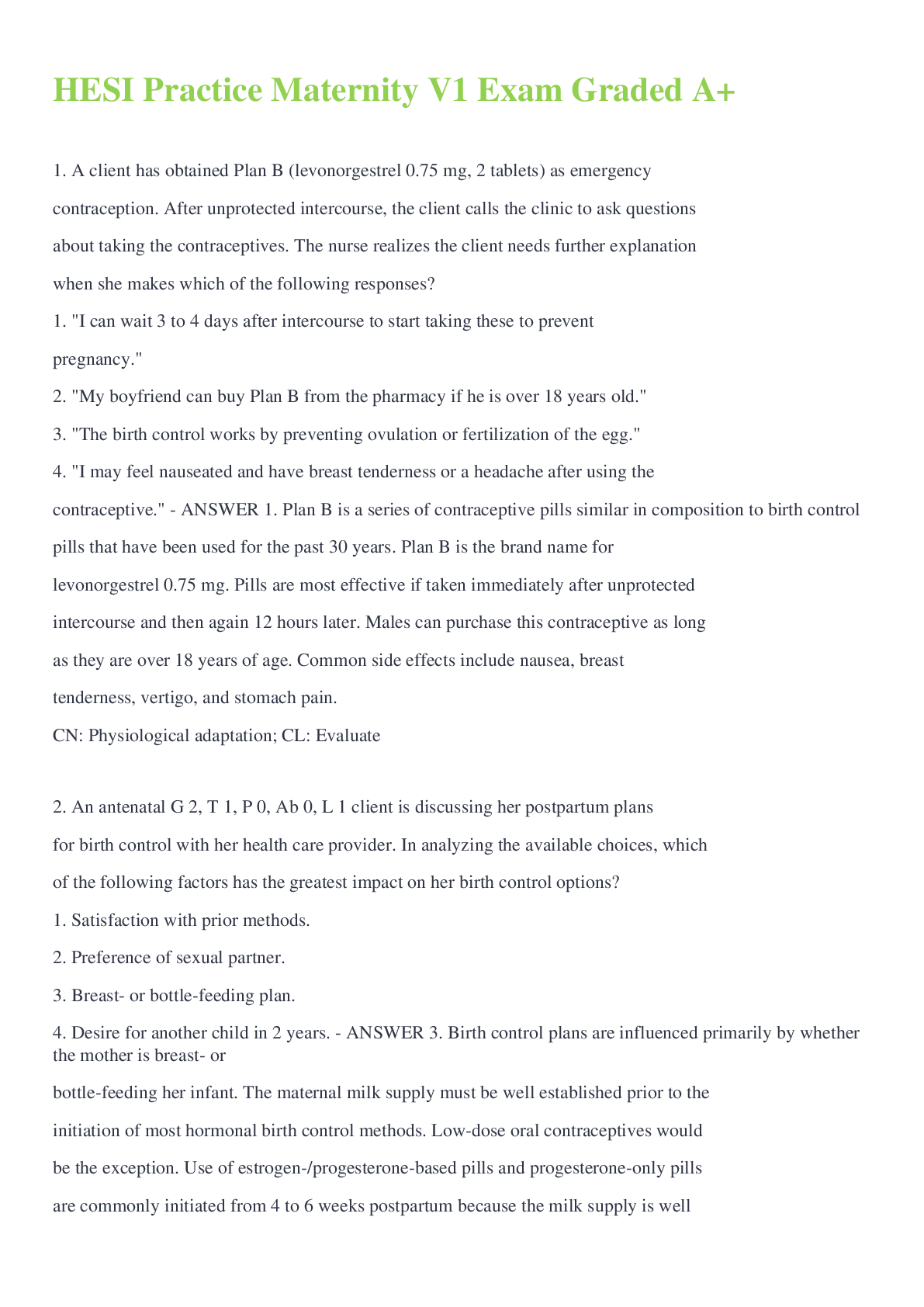
Reviews( 0 )
Document information
Connected school, study & course
About the document
Uploaded On
Nov 29, 2022
Number of pages
24
Written in
Additional information
This document has been written for:
Uploaded
Nov 29, 2022
Downloads
0
Views
166













 (1).png)



